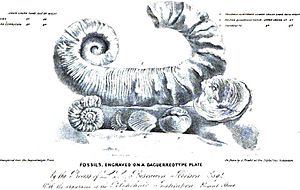Levett Landon Boscawen Ibbetson facts for kids


Captain Levett Landon Boscawen Ibbetson (born 1799 – died 1869) was an amazing English person from the 1800s. He was a geologist (someone who studies rocks and the Earth), an inventor, an organiser, and a soldier. He's especially known for his early work with photography. He was also a member of important groups like the London Electrical Society and later a Fellow of the famous Royal Society.
Contents
Life and Discoveries
Early Photography Work
From his home in London, Ibbetson experimented a lot with early photography. In 1842, he wrote to William Henry Fox Talbot, another photography pioneer. Ibbetson had been trying for years to create a lithograph (a type of print) from an original daguerreotype (an early photograph). He wrote that he was getting "very good results" with his experiments.
Ten years later, in 1852, Ibbetson showed off his work at an exhibition in London. He displayed a book called Le Premier Livre Imprimè par le Soleil (which means 'The First Book Printed by the Sun'). This book, first published in 1840, was an album of contact prints. It showed pictures of ferns, grasses, and flowers. He used a process similar to one invented by Friedrich Gerber in 1839.
Geology Adventures
Captain Ibbetson was a very keen geologist. He made many exciting finds. For example, on the Isle of Wight, he found the fossilised remains of a Hybodus, which was a type of ancient shark. This important fossil was sent to Sir Philip Malpas de Grey Egerton and was talked about by the Geological Society in 1845.
During the 1840s, Ibbetson also worked on different geological surveys. These surveys were needed because the British railway system was growing fast. He often wrote to famous geologist Henry Thomas De la Beche about his work.
He also wrote a book around 1852 called Notes on the geology and chemical composition of the various strata in the Isle of Wight. This book even included a map that showed the land in 3D! With Professor Edward Forbes, he also wrote a description of the geology between Blackgang Chine and Atherfield Point on the Isle of Wight for the Geological Society.
Helping with the Great Exhibition
In 1851, Levett Ibbetson helped to organise the huge Great Exhibition in London. This was a massive event that showed off new inventions and art from around the world.
At this exhibition, public toilets were quite new and unusual. Ibbetson was given the job of writing an 'Official Report on the Waiting Rooms and Washing Places in the Exhibition Building'. He even recorded how popular they were! He noted that on one day, October 8, 1851, over 11,000 people used them.
Later Life and Legacy
Ibbetson passed away in 1869 in Biebrich, which is in Prussia (modern-day Germany). He had lived there for several years. Before he died, he gave a valuable collection of fossils to the Museum of Practical Geology in London.
He was also known for an illustration of a fossil in a magazine called The Westminster Review in 1840. This drawing is believed to be the first time someone used a bright light, called limelight, to make daguerreotypes faster.
Family Life
Captain Levett Landon Boscawen Ibbetson was the son of Sophy and Major Levett Ibbetson. His own son, Major Henry Levett Boscawen Ibbetson, also became a soldier in the British Army. The family lived in West Teignmouth, Devon, England.

